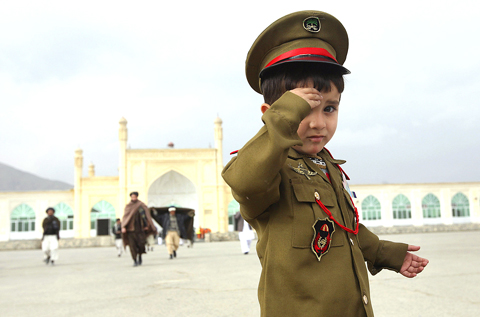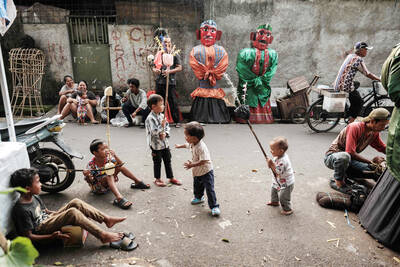The Taliban hold a permanent presence in 72 percent of Afghanistan, a think tank said yesterday, but NATO said the figures were not credible and it was impossible for militants to control large parts of the country.
The findings by the International Council on Security and Development (ICOS) come in the wake of a series of critical reports on Western-led military and development efforts to put an end to the seven-year Taliban insurgency in Afghanistan.
The US government is itself now conducting a wide-ranging review of strategy aimed at countering the Taliban guerrilla and bombing campaign that analysts agree has grown in both scale and scope in the last year.

PHOTO: AP
But while the trends in the ICOS report reflected prevailing sentiment on Afghanistan, many of its findings appeared flawed and contained some glaring errors, security analysts said.
“The Taliban now has a permanent presence in 72 percent of the country,” ICOS, formerly known as the Senlis Council, said in the report, adding that the figure had risen from 54 percent last year.
The report defines a permanent presence as an average of one or more insurgent attacks per week over the entire year.
ICOS said a “permanent presence” then would include many areas of the country where the Taliban traditionally launch a large number of attacks in the spring and summer “fighting season,” before melting away during the harsh winter months.
“We don’t see the figures in this report as being credible at all,” NATO spokesman James Appathurai said. “The Taliban are only present in the south and east which is already less than 50 percent of the country.”
At least 4,000 people have been killed in fighting in Afghanistan this year, around a third of them civilians, UN figures show.
In the traditional Taliban heartlands of the mainly ethnic Pashtun south and east, NATO-led and US-led coalition forces are engaged in daily clashes with militants fighting to overthrow the Afghan government and drive out foreign troops.
But the insurgents generally shy away from massed attacks against Afghan and international troops, preferring “shoot and scoot” ambushes, backed by roadside and suicide bomb attacks.
The Taliban, Appathurai said, “don’t control any areas where Afghan and international forces are present. Whenever Afghan or international forces patrol into an area they simply run away. So the idea that the Taliban control large swathes of the country is simply impossible.”
ICOS said the Taliban was “closing a noose” around the Afghan capital, Kabul, “establishing bases close to the city from which to launch attacks ... Using these bases, the Taliban and insurgent attacks in Kabul have increased dramatically.”
While the Taliban have built up a presence in provinces just to the south, west and east of Kabul in the last year, the number of insurgent attacks inside the city has actually gone down this year, the UN said.
That is largely because of a much stronger and highly visible police presence in the city in response to a series of high profile suicide attacks in Kabul last year.
ICOS said Kabul was “virtually Taliban-free a year ago” and said in the city there were “no police checkpoints at night and few in the day.”
An ICOS map of Kabul also showed the area occupied by the US embassy, the sprawling NATO headquarters and the Afghan presidential palace as one of “high Taliban/criminal activity.”
Fugitive Taliban leader Mullah Omar is promising more violence over the coming year, even as the US plans to deploy thousands more troops in hopes of turning around the deteriorating war in Afghanistan.
In a statement posted on Sunday on a militant-linked Web site, Omar also rejected Afghan President Hamid Karzai’s calls for peace talks until foreign troops leave the country.
Afghanistan is going through its most violent period since the Taliban was ousted in the US-led invasion in 2001.

In the sweltering streets of Jakarta, buskers carry towering, hollow puppets and pass around a bucket for donations. Now, they fear becoming outlaws. City authorities said they would crack down on use of the sacred ondel-ondel puppets, which can stand as tall as a truck, and they are drafting legislation to remove what they view as a street nuisance. Performances featuring the puppets — originally used by Jakarta’s Betawi people to ward off evil spirits — would be allowed only at set events. The ban could leave many ondel-ondel buskers in Jakarta jobless. “I am confused and anxious. I fear getting raided or even

Kemal Ozdemir looked up at the bare peaks of Mount Cilo in Turkey’s Kurdish majority southeast. “There were glaciers 10 years ago,” he recalled under a cloudless sky. A mountain guide for 15 years, Ozdemir then turned toward the torrent carrying dozens of blocks of ice below a slope covered with grass and rocks — a sign of glacier loss being exacerbated by global warming. “You can see that there are quite a few pieces of glacier in the water right now ... the reason why the waterfalls flow lushly actually shows us how fast the ice is melting,” he said.

Eleven people, including a former minister, were arrested in Serbia on Friday over a train station disaster in which 16 people died. The concrete canopy of the newly renovated station in the northern city of Novi Sad collapsed on Nov. 1, 2024 in a disaster widely blamed on corruption and poor oversight. It sparked a wave of student-led protests and led to the resignation of then-Serbian prime minister Milos Vucevic and the fall of his government. The public prosecutor’s office in Novi Sad opened an investigation into the accident and deaths. In February, the public prosecutor’s office for organized crime opened another probe into

RISING RACISM: A Japanese group called on China to assure safety in the country, while the Chinese embassy in Tokyo urged action against a ‘surge in xenophobia’ A Japanese woman living in China was attacked and injured by a man in a subway station in Suzhou, China, Japanese media said, hours after two Chinese men were seriously injured in violence in Tokyo. The attacks on Thursday raised concern about xenophobic sentiment in China and Japan that have been blamed for assaults in both countries. It was the third attack involving Japanese living in China since last year. In the two previous cases in China, Chinese authorities have insisted they were isolated incidents. Japanese broadcaster NHK did not identify the woman injured in Suzhou by name, but, citing the Japanese